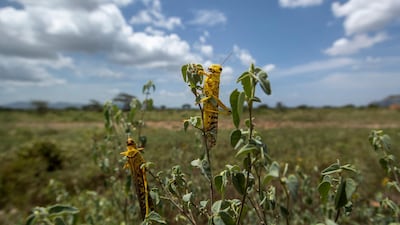Hundreds of millions of desert locusts have swept over East Africa, destroying crops, ravaging pastures and threatening to worsen a hunger crisis in some of the world’s most vulnerable countries.
The worst outbreak in decades has affected Ethiopia, Kenya and Somalia – and the number of locusts could grow by 500 times by June, the United Nations said.
Swarms are now expected to move into Uganda and South Sudan – a country where almost half of the population is already considered food insecure as it emerges from a civil war.
According to the UN's Food and Agriculture Organisation emergency response leader Rosanne Marchesich, it is the biggest outbreak Kenya has seen in 70 years and the worst seen by Ethiopia and Somalia in 25 years.
The crisis comes after three years of droughts, floods and unrest have left up to 25 million people already struggling with food insecurity in East Africa.
Increasingly erratic weather has aggravated the outbreak, according Oxfam’s regional humanitarian coordinator Francesco Rigamonti.
"This outbreak was clearly worsened by unusually heavy rains in the region and there is an interaction with the unusual cyclonic activity," Mr Rigamonti told the Thomson Reuters Foundation.
"It's difficult to say that it is due to climate change – but there is an interaction between the two.
“What we do know is that we are having a lot of extreme events like droughts, floods and now locusts in the region, so we need to be prepared."
What role has climate change played?
Rapidly warming waters in the Indian Ocean saw an unusual number of tropical cyclones off East Africa in 2019, leading to heavy rainfall and warmer temperatures that created favourable breeding conditions for locusts.
The ocean warming was caused by a climate condition known as the Indian Ocean Dipole – or the Indian Ocean Nino – which also contributed to severe droughts in Australia, where bushfires and dust storms have been wreaking havoc for months.
The phenomenon was first identified by researches in 1999 and shows a pattern of sea-surface temperature cycles in the Indian Ocean.
Positive IOD events, where higher-than-average sea temperatures and greater rainfall in the western region corresponds with cooler waters in the east, appear to have increased in strength and frequency during the 20th century, corresponding with a warming climate caused by increased greenhouse gas emissions.
There was a particularly strong positive IOD towards the end of 2019, leading to much higher than average rainfall over East Africa, causing devastating floods.
Roxy Koll Mathew, a climate scientist from the Indian Institute of Tropical Meteorology in Pune, said the warmer seas were partly attributable to climate change.
"The West Indian Ocean, including the Arabian Sea, was warmer than usual during the last two seasons," Dr Mathew told the Thomson Reuters Foundation.
"This is largely due to a phenomenon called Indian Ocean Dipole, and also due to the rising ocean temperatures associated with global warming."
Keith Cressman, senior locust forecasting officer at the FAO, said cyclones were known originators of swarms. There were two cyclones in 2018 and eight in 2019 – the most in one year since 1976.
“In the past 10 years, there's been an increase in the frequency of cyclones in the Indian Ocean," Mr Cressman said. "Normally there's none, or maybe one. So this is very unusual.”
“It's difficult to attribute to climate change directly, but if this trend of increased frequency of cyclones in Indian Ocean continues, then certainly that's going to translate to an increase in locust swarms in the Horn of Africa."
Guleid Artan from regional expert group, the Climate Prediction and Applications Centre, said the locust surge was the latest symptom of extreme weather conditions.
"We know East Africa is one of the most vulnerable to climate change. We know this region will see more extremes," he said.










